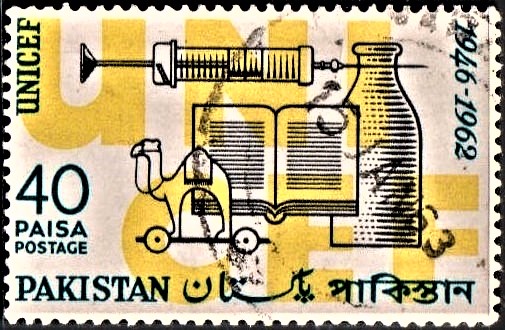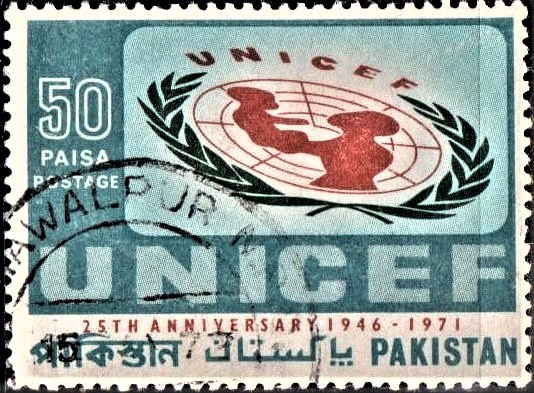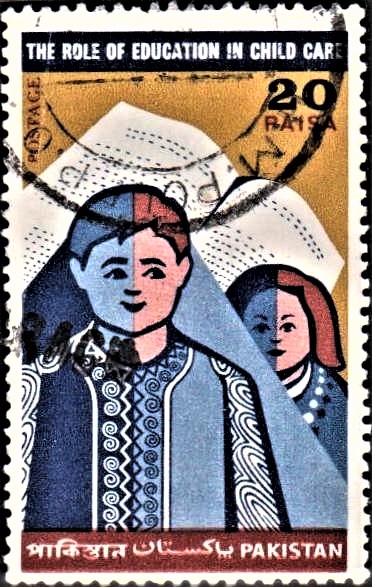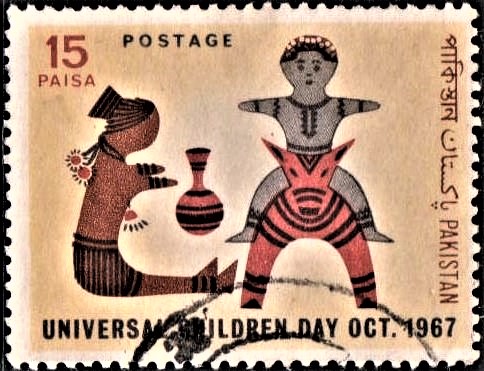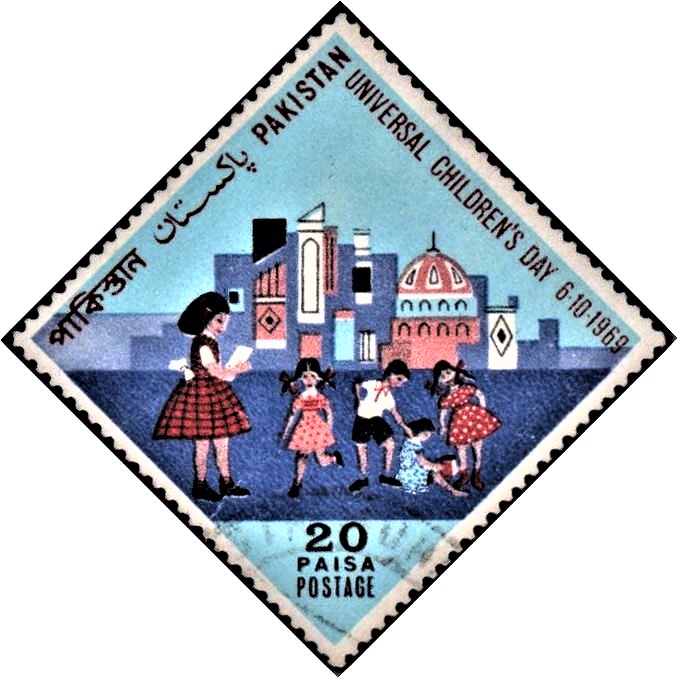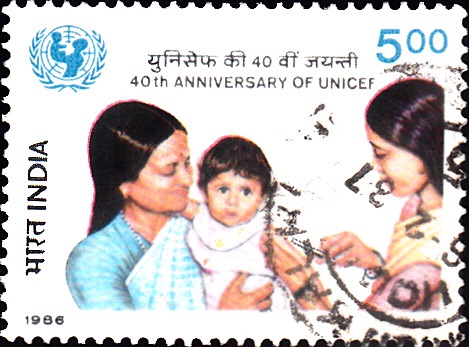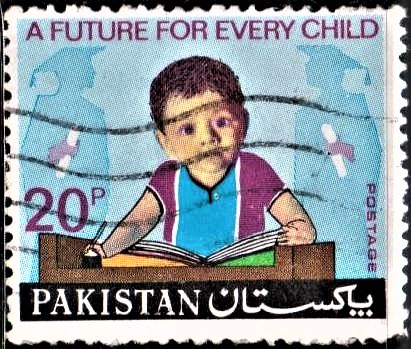
Pakistan on Universal Children’s Day 1974
A commemorative postage stamp on the Universal Children Day – A Future for Every Child :
 Issued by Pakistan
Issued by Pakistan
Issued on Oct 7, 1974
Design : The stamp is horizontal in format. A keen young boy is shown sitting by the desk holding an open book with his left hand and a pen in his right hand. The boy is wearing a blue shirt and mauve colour jersey. In the blue background are shown silhouetted form of Graduates on either side of the stamp holding degrees in their hands.
The slogan “A Future for Every Child” appears at the top of the stamp in mauve colour. The denomination ’20-P’ appears in mauve colour on the left side of the stamp just over the right edge of the desk. The word ‘postage’ in small letters appears in mauve along side the lower right edge of the stamp.
‘Pakistan‘ in English and Urdu appears in reverse in the black strip at the bottom of the stamp.
Type : Stamp, Postal Used
Denomination : 20 Paisa
Colours : Yellow / Magenta / Cyan / Black
Size of stamp : 28.65 x 34.00 m.m.
Size of print : 25.65 x 31.00 m.m.
Perforation Gauge : 13 x 13 (C)
Quantity : 5,00,000
Number of Stamps in each sheet : 50 (fifty)
Process of printing : Litho Offset
Printers : Pakistan Security Printing Corporation Ltd., Karachi
About :
- A Future for Every Child
- Every year “Universal Children Day” is celebrated throughout the world on the first Monday of October. A world-wide “Children Day” was originally proposed in 1952 by the International Union for Child Welfare (IUCW) and was celebrated for the first time internationally in October, 1953; 40 countries participated. When the United Nations General Assembly passed a formal Resolution establishing ‘Universal Children Day’ in 1954, it assigned to UNICEF the responsibility for promoting this annual “day of world-wide fraternity and understanding among children”. The number of countries and territories in which the Day is observed now has risen from 40 in 1953 to more than 100.
- The universality of children is the permanent underlying theme. In addition, each year a special theme is chosen to stress one important aspect of children’s lives. This year the special theme is “A FUTURE FOR EVERY CHILD”.
- The current year has been designated as “World Population Year” by the United Nations and a year-long effort is being made by many organizations to alert people everywhere to the importance of facing and solving population problems.
- The United Nations Children’s Fund (UNICEF) is inevitably concerned with these problems, because too-rapid population growth places too-great stresses on maternal and child health and on the medical, educational and social welfare services that are needed to protect and prepare children. UNICEF’s special focus is always on the needs of the individual child, so its slogan for World Population Year is “A Future for Every Child”.
- UNICEF’s work has expanded however, during the past two decades, into many other fields: health services, nutrition, education, vocational training, social welfare, environmental sanitation, community development and national planning, although it is still efficiently active in response to emergencies which threaten the health and lives of children.
- UNICEF is today no longer simply a humanitarian relief fund. It is primarily a developmental organization working with governments to help them establish long-range national policies to protect and prepare children and to develop young human resources.
- What Point is There in Increasing the Chances of A Child’s Survival in a Crowded World ?
- UNICEF believes that once a child is born everything must be done to ensure his chance to live, to be healthy and to be educated and trained for future as a responsible adult. It is in the interest of society in all parts of the world to improve the quality of its human capital and ensure that the child of today can become an active participant in tomorrow’s world. If a child is sick, suffering from malnutrition and condemned to ignorance, he cannot do this, and if he does survive to manhood, he will be a burden to society rather than an asset.
- UNICEF recognizes that the health and welfare of children and the family are profoundly influenced by the size of the faculty and the spacing of births. When requested to do so by a government, the Fund assists family planning as part of maternal and child health services. UNICEF aid for other services, which help raise the status of women (education and training of women, social welfare, community development, home economics extension, etc.) help increase motivation for responsible parenthood.
- Children represent the most valuable asset of parents, particularly as they look forward to their declining years. If parents can be convinced that their children will be healthy and survive to adulthood, they are likely to have smaller families.
- Lest We Forget : Children’s Rights are Still Neglected
- Last year was designated by the United Nations as “Human Rights Year”, and the current year is “World Population Year”. Unfortunately, the fact that a given year is chosen to acquaint the public with a particular social problem does not mean that the problem disappears by the end of that year. Social problems are inextricably inter-related and their roots are far too deep to be pulled up in 365 days. It would therefore be too bad if, when the year ends, everyone dismissed the old problem to turn to the next one.
- This past year was also the 14th anniversary of the unanimous passage by the United Nations General Assembly of the “Declaration of the Rights of the Child”, yet there are still many parts of the world where the inborn right of all children to receive the health care, education and protection from social injustices which they need, exists in theory only.
- Issued by The Director-General, Pakistan Post Office, Karachi.


